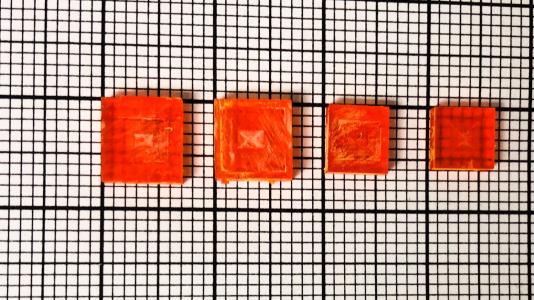2023-09-29 アルゴンヌ国立研究所(ANL)

Cesium bromide perovskite crystals demonstrate impressive ability to detect X-rays from large synchrotron facilities. (Image by Argonne National Laboratory.)
◆アルゴンヌ国立研究所の科学者チームは、優れた性能を示す新しい検出材料を開発し、シンクロトロンベースのX線研究で広く利用される可能性があります。この材料は、高エネルギーX線の実験をサポートし、素材の微細な変化を検出してより詳細な研究を可能にします。
<関連情報>
- https://www.anl.gov/article/scientists-discover-a-durable-but-sensitive-material-for-high-energy-xray-detection
- https://onlinelibrary.wiley.com/doi/abs/10.1002/adom.202202946
- https://onlinelibrary.wiley.com/doi/10.1002/adma.202211840
1010 Photons s-1 mm-2で動作するペロブスカイト型CsPbBr3単結晶半導体検出器による超高フラックスX線検出 Perovskite CsPbBr3 Single-Crystal Detector Operating at 1010 Photons s−1 mm−2 for Ultra-High Flux X-ray Detection
Lei Pan, Indra Raj Pandey, Antonino Miceli, Vladislav V. Klepov, Duck Young Chung, Mercouri G. Kanatzidis
Advanced Optical Materials Published: 29 January 2023
DOI:https://doi.org/10.1002/adom.202202946
Abstract
Semiconductors for detecting hard radiation are confronted with considerable problems when operating at high photon fluxes. A perovskite CsPbBr3 single-crystal detector capable of operating at X-ray fluxes of up to 1010 photons s−1 mm−2 with beam area ≤ 0.25 mm2 at 58.61 keV for current-mode X-ray detection is reported. The spectrometer-grade melt-grown CsPbBr3 detectors show a gamma-ray energy resolution of ~7.5% at 122 keV for 57Co and dark current as low as 4.3 nA (0.5 nA mm−2) at a reverse bias voltage of 200 V (118 V mm−1). The detector is tested at X-ray energies of 8.2, 10, and 58.61 keV at a synchrotron light source under a reverse bias voltage of up to 1000 V (588 V mm−1). Under a sufficiently high bias voltage and within several hundreds of seconds X-ray exposure, good photocurrent linearity (goodness of fit R2 > 0.99) and reproducibility are obtained up to a flux of ≈1010 photons s−1 mm−2 at beam area 0.25 mm2 with Lower Limit of Detection of ≈105 photons s−1 mm−2 and Charge Collection Efficiency of ≈100% for 58.61 keV X-rays. Accordingly, wide application of CsPbBr3 detectors in high-flux X-ray detection is anticipated.
溶液成長ペロブスカイト型CsPbBr3単結晶半導体検出器による超高輝度X線検出 Ultrahigh-Flux X-ray Detection by a Solution-Grown Perovskite CsPbBr3 Single-Crystal Semiconductor Detector
Lei Pan, Zhifu Liu, Claire Welton, Vladislav V. Klepov, John A. Peters, Michael C. De Siena, Alessandro Benadia, Indra Pandey, Antonino Miceli, Duck Young Chung, G. N. Manjunatha Reddy, Bruce W. Wessels, Mercouri G. Kanatzidis
Advanced Materials Published: 21 March 2023
DOI:https://doi.org/10.1002/adma.202211840
Abstract
Solution-processed perovskites are promising for hard X-ray and gamma-ray detection, but there are limited reports on their performance under extremely intense X-rays. Here, a solution-grown all-inorganic perovskite CsPbBr3 single-crystal semiconductor detector capable of operating at ultrahigh X-ray flux of 1010 photons s−1 mm−2 is reported. High-quality solution-grown CsPbBr3 single crystals are fabricated into detectors with a Schottky diode structure of eutectic gallium indium/CsPbBr3/Au. A high reverse-bias voltage of 1000 V (435 V mm−1) can be applied with a small and stable dark current of ≈60–70 nA (≈9–10 nA mm−2), which enables a high sensitivity larger than 10 000 µC Gyair−1 cm−2 and a simultaneous low detection limit of 22 nGyair s−1. The CsPbBr3 semiconductor detector shows an excellent photocurrent linearity and reproducibility under 58.61 keV synchrotron X-rays with flux from 106 to 1010 photons s−1 mm−2. Defect characterization by thermally stimulated current spectroscopy shows a similar low defect density of a synchrotron X-ray and a lab X-ray irradiated device. Solid-state nuclear magnetic resonance spectroscopy suggests that the excellent performance of the solution-grown CsPbBr3 single crystal may be associated with its good short-range order, comparable to the spectrometer-grade melt-grown CsPbBr3.



